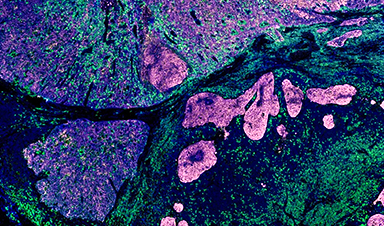A study in Scientific Reports evaluated a photoacoustic polydopamine-indocyanine green (PDA-ICG) nanoprobe for detecting senescent cells. Senescent cells play a role in tumor progression and therapeutic resistance, with potential adverse effects such as inflammation and tissue disruption. The PDA-ICG nanoprobe offers a method for identifying these cells, with implications for cancer diagnostics and treatment.
Background
Cellular senescence is a stable cell cycle arrest triggered by stressors such as DNA damage, oxidative stress, and oncogenic signaling. Senescent cells produce pro-inflammatory cytokines, growth factors, and proteases, collectively known as the senescence-associated secretory phenotype (SASP).
This phenomenon contributes to tumor progression and age-related diseases. Accurately identifying and visualizing these cells in vivo is crucial for understanding their role in cancer biology and developing targeted therapies.
Traditional methods for detecting senescent cells, such as β-galactosidase staining and immunohistochemistry, have limitations in terms of specificity and sensitivity. The introduction of advanced imaging techniques, particularly those utilizing nanoprobes, offers a promising avenue for enhancing the detection of senescent cells.
The PDA-ICG nanoprobe combines the photothermal properties of polydopamine with the fluorescence of indocyanine green, enabling both photoacoustic imaging and fluorescence imaging. This dual functionality is expected to improve the visualization of senescent cells.
The Current Study
The study used experimental techniques to evaluate the performance of the PDA-ICG nanoprobe. Human cancer cell lines, A549 and SK-MEL-103, were cultured and treated with varying concentrations of PDA-ICG to assess cell viability and nanoprobe internalization.
The MTS assay measured cell viability after treatment, and flow cytometry assessed nanoprobe internalization in live cells. After treatment, cells were washed to remove excess probes and stained with DAPI for flow cytometric analysis. Data were processed using FlowJo software to identify live, single-cell populations with internalized nanoprobe.
Cells were treated with chemotherapeutic agents, cisplatin and palbociclib, for a specified duration. After drug removal, the cells were stained with β-galactosidase to identify senescent cells. RNA extraction and quantitative real-time PCR (RT-qPCR) were performed to measure the expression levels of senescence-associated genes.
Western blotting was conducted to analyze protein expression related to senescence, including p21 and pRb. Confocal microscopy was utilized to visualize the cellular localization of the PDA-ICG nanoprobe and assess its potential for imaging senescent cells.
Results and Discussion
The results showed that the PDA-ICG nanoprobe was successfully internalized into cancer cells, with flow cytometry confirming significantly higher uptake in treated cells than controls. The MTS assay indicated no adverse effects on cell viability at the tested concentrations, supporting its potential for safe in vivo application.
The study also found that treatment with cisplatin and palbociclib successfully induced senescence in the respective cell lines, as evidenced by increased β-galactosidase activity. The expression of senescence-associated genes was significantly elevated in treated cells, further confirming the induction of senescence.
Confocal microscopy highlighted the PDA-ICG nanoprobe’s imaging capabilities, revealing distinct localization patterns within the cells. The nanoprobe’s dual imaging modality allowed for more precise visualization of senescent cells than traditional methods. The findings suggest that the PDA-ICG nanoprobe could serve as a valuable tool for studying the dynamics of senescence in cancer and other diseases.
The ability to visualize senescent cells in real time may facilitate the development of targeted therapies that eliminate these cells from the tumor microenvironment, potentially improving patient outcomes.
Conclusion
The study successfully demonstrated the utility of the PDA-ICG nanoprobe for detecting senescent cells in cancer. Combining the advantages of photoacoustic and fluorescence imaging, this innovative approach offers a promising strategy for enhancing the visualization of senescence in vivo. The findings underscore the importance of accurately identifying senescent cells in the context of cancer biology and therapeutic interventions.
Future research should focus on optimizing the nanoprobe for clinical applications and exploring its potential in various cancer models. The ability to monitor senescence dynamically could lead to significant advancements in cancer diagnostics and treatment, ultimately contributing to improved patient care and outcomes.
Journal Reference
Hartono, M., et al. (2024). Photoacoustic polydopamine-indocyanine green (PDA-ICG) nanoprobe for detection of senescent cells. Scientific Reports. DOI: 10.1038/s41598-024-79667-7, https://www.nature.com/articles/s41598-024-79667-7
News
Scientists Unlock a New Way to Hear the Brain’s Hidden Language
Scientists can finally hear the brain’s quietest messages—unlocking the hidden code behind how neurons think, decide, and remember. Scientists have created a new protein that can capture the incoming chemical signals received by brain [...]
Does being infected or vaccinated first influence COVID-19 immunity?
A new study analyzing the immune response to COVID-19 in a Catalan cohort of health workers sheds light on an important question: does it matter whether a person was first infected or first vaccinated? [...]
We May Never Know if AI Is Conscious, Says Cambridge Philosopher
As claims about conscious AI grow louder, a Cambridge philosopher argues that we lack the evidence to know whether machines can truly be conscious, let alone morally significant. A philosopher at the University of [...]
AI Helped Scientists Stop a Virus With One Tiny Change
Using AI, researchers identified one tiny molecular interaction that viruses need to infect cells. Disrupting it stopped the virus before infection could begin. Washington State University scientists have uncovered a method to interfere with a key [...]
Deadly Hospital Fungus May Finally Have a Weakness
A deadly, drug-resistant hospital fungus may finally have a weakness—and scientists think they’ve found it. Researchers have identified a genetic process that could open the door to new treatments for a dangerous fungal infection [...]
Fever-Proof Bird Flu Variant Could Fuel the Next Pandemic
Bird flu viruses present a significant risk to humans because they can continue replicating at temperatures higher than a typical fever. Fever is one of the body’s main tools for slowing or stopping viral [...]
What could the future of nanoscience look like?
Society has a lot to thank for nanoscience. From improved health monitoring to reducing the size of electronics, scientists’ ability to delve deeper and better understand chemistry at the nanoscale has opened up numerous [...]
Scientists Melt Cancer’s Hidden “Power Hubs” and Stop Tumor Growth
Researchers discovered that in a rare kidney cancer, RNA builds droplet-like hubs that act as growth control centers inside tumor cells. By engineering a molecular switch to dissolve these hubs, they were able to halt cancer [...]
Platelet-inspired nanoparticles could improve treatment of inflammatory diseases
Scientists have developed platelet-inspired nanoparticles that deliver anti-inflammatory drugs directly to brain-computer interface implants, doubling their effectiveness. Scientists have found a way to improve the performance of brain-computer interface (BCI) electrodes by delivering anti-inflammatory drugs directly [...]
After 150 years, a new chapter in cancer therapy is finally beginning
For decades, researchers have been looking for ways to destroy cancer cells in a targeted manner without further weakening the body. But for many patients whose immune system is severely impaired by chemotherapy or radiation, [...]
Older chemical libraries show promise for fighting resistant strains of COVID-19 virus
SARS‑CoV‑2, the virus that causes COVID-19, continues to mutate, with some newer strains becoming less responsive to current antiviral treatments like Paxlovid. Now, University of California San Diego scientists and an international team of [...]
Lower doses of immunotherapy for skin cancer give better results, study suggests
According to a new study, lower doses of approved immunotherapy for malignant melanoma can give better results against tumors, while reducing side effects. This is reported by researchers at Karolinska Institutet in the Journal of the National [...]
Researchers highlight five pathways through which microplastics can harm the brain
Microplastics could be fueling neurodegenerative diseases like Alzheimer's and Parkinson's, with a new study highlighting five ways microplastics can trigger inflammation and damage in the brain. More than 57 million people live with dementia, [...]
Tiny Metal Nanodots Obliterate Cancer Cells While Largely Sparing Healthy Tissue
Scientists have developed tiny metal-oxide particles that push cancer cells past their stress limits while sparing healthy tissue. An international team led by RMIT University has developed tiny particles called nanodots, crafted from a metallic compound, [...]
Gold Nanoclusters Could Supercharge Quantum Computers
Researchers found that gold “super atoms” can behave like the atoms in top-tier quantum systems—only far easier to scale. These tiny clusters can be customized at the molecular level, offering a powerful, tunable foundation [...]
A single shot of HPV vaccine may be enough to fight cervical cancer, study finds
WASHINGTON -- A single HPV vaccination appears just as effective as two doses at preventing the viral infection that causes cervical cancer, researchers reported Wednesday. HPV, or human papillomavirus, is very common and spread [...]






















